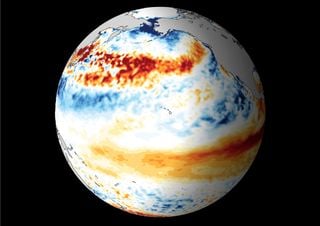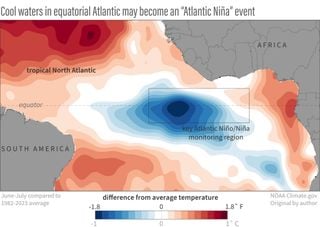El Niño influence can be delayed by up to a year
The impact of one of the world’s most influential global climate patterns is much more far reaching than originally thought.

Weather conditions in one region can affect those in another, distant location in what’s known as an atmospheric teleconnection.
The El Niño Southern Oscillation (ENSO) occurs in the Pacific yet can influence conditions in the Atlantic through its effect on the extratropical jet stream. New research from the Met Office has shown that this effect can be delayed, by a full year after the original event.
Winter weather
This one year delayed response is as strong as the simultaneous response, but with the opposite effect. For example, the El Niño can increase the chances of colder winters in the UK yet result in a milder winter the next year. While ENSO is one of many factors influencing UK weather, it can be important, particularly in the winter months.
“This latest research reveals that El Niño is often followed by positive North Atlantic Oscillation (NAO) a whole year later, while La Niña is followed by negative NAO one year later,” explains lead researcher, Met Office’s Professor Adam Scaife. “This has major implications for understanding ENSO, explaining our winter climate variability and interpreting long range predictions.”
“This is exciting new research which reveals unexpected potential for valuable forecasts of UK and European winter weather over a year ahead,” adds Professor Rowan Sutton, Director of the Met Office Hadley Centre. “Such forecasts could be valuable for long-range risk and contingency planning, for example in the energy sector or in flood preparedness”.
ENSO’s irregular shift
The research shows that knowing what happened in previous winter ENSO events is important for understanding some of our extreme winters. Where an El Niño is followed by La Niña, or vice versa, the lagged effects can boost expected impacts; for example, in 1968/69, 1976/77, 2009/10, La Niña was followed by El Niño, and increased the subsequent cold weather, while there were mild and stormy weather in the winters of 1988/89, 1998/99, 2007/8 when El Niño was followed by La Niña.

The ENSO shifts back and forth irregularly, roughly every two to seven years; it brings with it predictable shifts in ocean surface temperature and disrupts wind, rainfall and global temperature patterns across the tropics.
With increased understanding of the teleconnections and impacts of ENSO, the researchers say they will be better able to plan for variations in winter weather patterns.
News reference
Adam A. Scaife et al. (2024) ENSO affects the North Atlantic Oscillation 1 year later, Science



